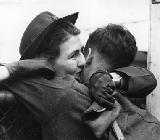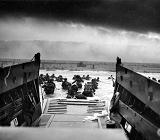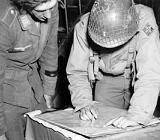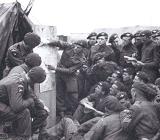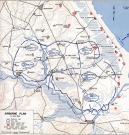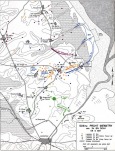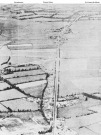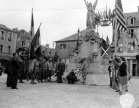The American Airborne Assault
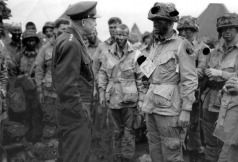
Eisenhower with the US Paras on June 5th
Hours before any Allied soldier landed from the sea, tens of thousands of Paratroopers were dropped behind the assault beaches to guard the flanks against German counterattack. Sent in behind Utah Beach to protect the US VII Corps flank, to capture strategically important villages, bridges and crossroads and to destroy key German installations before they could be brought to bear on the Allied fleet, the men of the American 82nd and 101st Airborne Assault Divisions were badly scattered during their drop. Most of the transport pilots flying the Airborne troopers to their Drop Zones had never flown through anti-aircraft fire before and that, combined with fog and low cloud, caused wide dispersal of the aircraft. After they landed few of the Para's knew where they were and most found themselves lost and alone, some having come down in areas deliberatly flooded by the Germans with disastrous consequences.
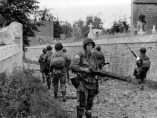
US Paras in a Norman Village
Enough of the Paratroopers landed close to their objectives to do the tasks assigned them, however, and with the arrival of the first glider lift at 4 am delivering in anti-tank and anti-aircraft guns as well as jeeps and specialist troops, the Para's were able to secure their targets to await the arrival of the seaborne assault. Although Paratrooper losses in excess of 50% had been predicted it turned out to have been unnecessarily pessimistic. The exploits of the American Paratroopers have now been immortalized in the HBO Television Series “Band of Brothers”.
The Battle Sites/Sights
US Paratrooper Sites to visit in Normandy
Ste Mere Eglise
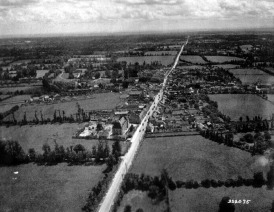
Aerial view of Ste Mere Eglise towards Carentan
Although the most famous of the D-Day targets given to the American Airborne Forces in Normandy, it was only one of numerous villages to be capture and held. The village sat astride the junction of the main North-South and East-West roads behind Utah Beach and was therefore of crucial importance to the Paras on D-Day. Unfortunately, the German garrison in the village on D-Day was on alert when the paras started their drops and with some 50 of the parachute troopers mis-dropped on the village itself they were badly shot up on landing. However, the Germans evacuated the town a few hours later, never to return. They retreated mainly to the north in the direction of Cherbourg and although several armoured counter-attacks came down into Ste Mere Eglise from the direction they were beaten off by the badly out-numbered and out-gunned Paratroops. Once the town had been secured on D-Day apart from the counter-attacks from the north that were beaten off, the town was not really threatened again by the Germans, although it was shelled heavily until June 9th.
Sights/Sites to See
It was here that a Paratrooper called John Steel would ensure that for a whole generation the enduring image of D-Day would be a paratrooper dangling from a church steeple. You will see the church where this extraordinary story unfolded and hear the slightly less glamorous truth behind the “Poetic License” taken by Hollywood directors in their profession. You will also see the damage suffered by the houses in the village during the fighting in 1944, still visible today if you know where to look, as well as hearing the stories that unfolded in the village during the fighting on D-Day morning and subsequently.
Sights/Sites to See
It was here that a Paratrooper called John Steel would ensure that for a whole generation the enduring image of D-Day would be a paratrooper dangling from a church steeple. You will see the church where this extraordinary story unfolded and hear the slightly less glamorous truth behind the “Poetic License” taken by Hollywood directors in their profession. You will also see the damage suffered by the houses in the village during the fighting in 1944, still visible today if you know where to look, as well as hearing the stories that unfolded in the village during the fighting on D-Day morning and subsequently.
Hiesville and the surrounding area
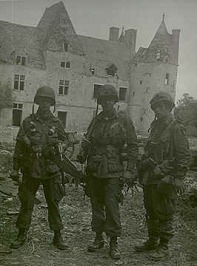
US Paras at Colombieres Chateau
The tiny little village of Hiesville is found right in the middle of the American 101st Airborne Division Drop Zone and was to become the main hub of operations for the 101st Airborne Division. The area was easily secured early on D-Day morning against light German resistance. However once General Taylor was informed that there was no contact with his units designated to secure Exits 1 and 2, the two southernmost roads leading inland from Utah Beach, he gathered the fighing troops that had assembled near his Head Quarters area. Leaving the Head quarters Staff to set up, the General departed almost immediately after arrival with only about 85 men to secure the Beach Exits himself. This job had had 750 men assigned to carry it out.
Sights/Sites to See
On your way along the road to see the house in Hiesville that was to serve as General Maxwell Taylors Divisional Headquarters you will see that you also pass the house being used initially as the Regimental Head Quarters of the 506th Infantry Regiment only a mile and a half away (2km) to the East. Landing Zone E where the glider-borne equipment was to come in is only a quarter of a mile (400 meters) to the south of General Taylor's Divisional Headquarters and it was here that the highest ranking officer to die on D-Day met his fate. You will be shown the memorial to Brigadier General Pratt, Assistant Commanding Officer of the 101st Airborne Division, who died when his glider crashed through a hedgerow after touching down on Landing Zone E. The General's death here was the exception, however, as most of the gliders that landed in this landing zone did so with few fatalities. Also just half a mile (800 meters) north of Hiesville the 326th Airborne Medical Company set up, for the first time, a Field Hospital behind enemy lines in the Chateau de Colomiere. It was successfully used as field hospital for the first three days after the landings but fortunatly when the Chateau was bombed by the Luftwaffe on June 9th it was just after the 400 casualties had been evacuated to Utah Beach the and the casualties were limited to a few men of the Medical Company.
Sights/Sites to See
On your way along the road to see the house in Hiesville that was to serve as General Maxwell Taylors Divisional Headquarters you will see that you also pass the house being used initially as the Regimental Head Quarters of the 506th Infantry Regiment only a mile and a half away (2km) to the East. Landing Zone E where the glider-borne equipment was to come in is only a quarter of a mile (400 meters) to the south of General Taylor's Divisional Headquarters and it was here that the highest ranking officer to die on D-Day met his fate. You will be shown the memorial to Brigadier General Pratt, Assistant Commanding Officer of the 101st Airborne Division, who died when his glider crashed through a hedgerow after touching down on Landing Zone E. The General's death here was the exception, however, as most of the gliders that landed in this landing zone did so with few fatalities. Also just half a mile (800 meters) north of Hiesville the 326th Airborne Medical Company set up, for the first time, a Field Hospital behind enemy lines in the Chateau de Colomiere. It was successfully used as field hospital for the first three days after the landings but fortunatly when the Chateau was bombed by the Luftwaffe on June 9th it was just after the 400 casualties had been evacuated to Utah Beach the and the casualties were limited to a few men of the Medical Company.
Ste Come du Mont
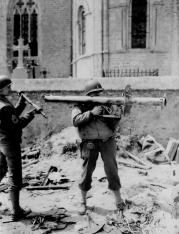
US Paras in St Come du Mont
Situated at the northern end of the road leading out of Carentan to the north, St Come du Mont was a strategically vital village for the paras to hold before they would be able to launch an attack into the town of Carentan itself. The Germans had the causeway leading into the town of Carentan covered with one of their dreaded “88's”, the feared German Anti-tank gun. The village of St Come du Mont got it's macabre nickname of “Dead man's Corner” from this gun when a tank of the 70th Tank Battalion got hit by it at the road junction and burned out with the commander sitting upright in the turret. This was the “Dead Man” of “Dead Man's Corner”. As the village was the last German defense point north of Carentan the Germans fought tenaciously to hold on to it, only finally relinquishing their hold to the 101st Airborne Division late on June 9th.
Sights/Sites to See
As well as being shown the Main German resistance point to the Paras advance into St Come du Mont, which is the house overlooking the main road junction in the village, (now been converted into the “Dead Man's Corner” Museum) this is where the Paratroopers attack south into Carentan for the crucial link-up with the US V Crops forces that had landed on Omaha Beach starts from. As you are driven along the road leading into the capture of the town, you will be shown where the German 88 Anti-tank Gun was positioned as well as the expanse of the flooded area to be traversed and four rivers to be crossed by the paras, all the while under German fire from the southern bank and all this before their attack on Carentan could even commence.
Sights/Sites to See
As well as being shown the Main German resistance point to the Paras advance into St Come du Mont, which is the house overlooking the main road junction in the village, (now been converted into the “Dead Man's Corner” Museum) this is where the Paratroopers attack south into Carentan for the crucial link-up with the US V Crops forces that had landed on Omaha Beach starts from. As you are driven along the road leading into the capture of the town, you will be shown where the German 88 Anti-tank Gun was positioned as well as the expanse of the flooded area to be traversed and four rivers to be crossed by the paras, all the while under German fire from the southern bank and all this before their attack on Carentan could even commence.
La Fiere Bridge and Col Timmes Position
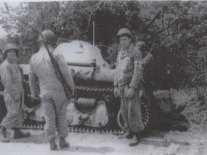
A tank knocked out at La Fiere bridge
This quiet bridge over the Merderet River some two miles (3km) west of Sainte-Mere-Eglise saw some of the fiercest fighting for the 82nd Airborne Division during their time in Normandy. The capture of this bridge at La Fiere was considered a pre-requisite to allow Allied forces to cross the Merderet River and push to the eastern side of the Cherbourg peninsula to isolate it for later capture. The Germans however understood the importance of this position and like at Angoville au Plain, were occupying the position for the Anti-Invasion Exercise that the 92nd German Air-Landing Division was carrying out with the 6th Parachute Regiment on the night of June 5th. Following an attack by the 505 Regiment in the early hours of June 6th the Germans were pushed out and the bridge then secured. While this was happening, Col Timmes gathered with elements of the 507th Regiment in an orchard just north of the road leading to the la Fiere Bridge on the west bank of the river. Although out of contact with the Paras on the bridge and completely unsure if the invasion had even succeeded, Col Timmes was occupying strategically important ground over and past which any German counterattack against the positions at the bridge would have to make their way. Although safe from being overrun by the Germans, Col Timmes' mixed Group of Paras was very exposed to German artillery and mortars and suffered heavily during the 3 days they occupied the orchard. The Germans launched an armoured counter attack on the afternoon of June 6th but were beaten back by the combined efforts of both groups of paratroopers. A second armoured attack on June 7th was also beaten off but by this stage the Paras were starting to ask; Where are the tanks? They had been told that the tanks coming inland from Utah Beach would be with them by lunch time of June 6th. Finally on the evening of June 7th support arrived but still no American tanks and the Paras spent most of June 8th still fighting off counter attacks. On June 9th the tanks finally arrived and were ready to advance across the causeway, finally securing the position and also carrying relief to the other two 82 Airborne Regiments that were isolated on the other side of the river Merderet.
Sights/Sites to See
On your way to this site you will be shown the field where the Glider carrying the 57mm Anti-tank gun used by the Para's at the bridge landed, the railway crossing used by General James Gavin to orientate himself in the pre-dawn of June 6th, and on the site you will see the positions occupied by Trooper Marcus Heim (whom the road is now named after) from where he helped to knock out two German tanks with his Bazooka, General Gavin's Fox-hole at the bridge and the numerous monuments that can be found at this historic site honouring the men who fought here, the most famous of these monuments being the Paratrooper statue of “Iron Mike”. Then you will be driven to the positions the Germans were occupying on the opposite side of the river in the church in Cauquiny and finally on to see the memorial to Col Timmes group at their position in the orchard.
Sights/Sites to See
On your way to this site you will be shown the field where the Glider carrying the 57mm Anti-tank gun used by the Para's at the bridge landed, the railway crossing used by General James Gavin to orientate himself in the pre-dawn of June 6th, and on the site you will see the positions occupied by Trooper Marcus Heim (whom the road is now named after) from where he helped to knock out two German tanks with his Bazooka, General Gavin's Fox-hole at the bridge and the numerous monuments that can be found at this historic site honouring the men who fought here, the most famous of these monuments being the Paratrooper statue of “Iron Mike”. Then you will be driven to the positions the Germans were occupying on the opposite side of the river in the church in Cauquiny and finally on to see the memorial to Col Timmes group at their position in the orchard.
Angoville au Plain
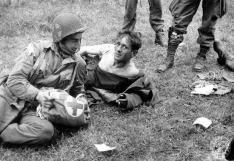
US Medic with Wounded German Prisoner
This tiny Norman village was to find itself at the heart of some of the fiercest fighting that the 101st Airborne Division were involved in following the D-Day landings in France. The village is situated about a quarter of a mile (400 meters) west of Drop Zone D and although the accuracy of this drop was one of the best achieved on D-Day it was a disaster. The 6th German FallschirmJager Regiment were on an anti-invasion exercise the night of June 5th. Unfortunately for the Paras of the 501st and 506th Parachute Infantry Regiments who landed in the right place, the Germans were waiting. For their exercise they had ringed the Drop Zone with machine guns as a precaution to it being a potential landing zone and upon seeing the parachutes for real, they opened fire.
Despite this the village was secured by the Americans in the early hours of June 6th, and the Paratroopers set to digging themselves into defensive positions and two 501st Regiment Medics, Robert Wright and Kenneth Moore, set up an aid station in the 12th century church. However with only 150 men to hold the village against an organised German regiment, defence was not feasible and the Germans recaptured the village later that morning. The medics chose to stay with the wounded in the church and when the Germans entered they saw the medics tending both American and German wounded as well as a local French child. The Germans called in their own doctor to assist the American medics in caring for the wounded. The village changed hands several times in the next two days, the medics staying all the time in the church, caring for the wounded of both sides.
Finally a concerted attack by the 506th Regiment of the 101st Airborne Division placed the village firmly in Allied hands and at final count the medics had looked after 80 combatants and one civilian over their three days in the church. Col Sink, commander of the 506th Regiment, moved his HQ into the village shortly after it's capture on June 8th to prepare for the attack towards St Come du Mont, already known to the troops as “Dead Man's Corner”, that was to follow.
Sights/Sites to see
Today the two medics, Robert Wright and Kenneth Moore, are commemorated in the stained glass windows in the church put in to honour the service that these brave men rendered to their enemys as well as their comrades. You will be shown the cracked flag-stone in the centre of the church floor, shattered by an exploding mortar bomb that came in a window, still there to be seen, as well as the bloodstains left on the wooden pews in the church by the wounded as they waited to be treated by the two medics. You will see the village square is now named “Place Toccoa” in honour of where the 101st Airborne Division was trained in the USA , and there is a memorial to the two medics in the village square as well.
Despite this the village was secured by the Americans in the early hours of June 6th, and the Paratroopers set to digging themselves into defensive positions and two 501st Regiment Medics, Robert Wright and Kenneth Moore, set up an aid station in the 12th century church. However with only 150 men to hold the village against an organised German regiment, defence was not feasible and the Germans recaptured the village later that morning. The medics chose to stay with the wounded in the church and when the Germans entered they saw the medics tending both American and German wounded as well as a local French child. The Germans called in their own doctor to assist the American medics in caring for the wounded. The village changed hands several times in the next two days, the medics staying all the time in the church, caring for the wounded of both sides.
Finally a concerted attack by the 506th Regiment of the 101st Airborne Division placed the village firmly in Allied hands and at final count the medics had looked after 80 combatants and one civilian over their three days in the church. Col Sink, commander of the 506th Regiment, moved his HQ into the village shortly after it's capture on June 8th to prepare for the attack towards St Come du Mont, already known to the troops as “Dead Man's Corner”, that was to follow.
Sights/Sites to see
Today the two medics, Robert Wright and Kenneth Moore, are commemorated in the stained glass windows in the church put in to honour the service that these brave men rendered to their enemys as well as their comrades. You will be shown the cracked flag-stone in the centre of the church floor, shattered by an exploding mortar bomb that came in a window, still there to be seen, as well as the bloodstains left on the wooden pews in the church by the wounded as they waited to be treated by the two medics. You will see the village square is now named “Place Toccoa” in honour of where the 101st Airborne Division was trained in the USA , and there is a memorial to the two medics in the village square as well.
Ste Marie du Mont
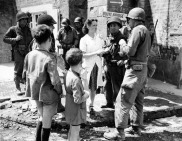
US Paras in Ste Marie du Mont
Located at the first major road intersection inland from Utah Beach, Sainte Marie du Mont was one of the main D-Day objectives for the 101st Airborne Division. This village was the first large settlement on the main advance route to Carentan for the sea-borne forces, but because of the very scattered night drop, Sainte Marie du Mont was not finally secured until the afternoon of D-Day. The fighting in the town on D-Day was mostly the American and German paratroopers in the vicinity vying for the best position until reinforcements arrived to help. Once the US Paras held the village they had denied to the Germans the best observation point that they had had down to Utah Beach. Luckily for the American Forces, the American reinforcements coming from the beach arrived quickest, mainly thanks to the work done by other American Paratrooper units further south, west and north in stopping the Germans from being able to plan any properly organised attacks against any American positions until after the Utah Landing Beach Head was already secure. Amerian troops and supplies were heading inland through the village before nightfall on June 6th.
Sights/Sites to See
You will see that dome of the 13th Century church steeple in Ste Marie du Mont still shows where the concrete had to be repaired after the American Paratroopers used a captured German artillery piece to “persuade” the German soldiers who were occupying the dome that it was time to depart. The inside walls of the church itself still show the scars of the running gun battle fought inside the church on D-Day, as well as numerous monuments to the American Forces that are dotted around the village square outside the church.
Sights/Sites to See
You will see that dome of the 13th Century church steeple in Ste Marie du Mont still shows where the concrete had to be repaired after the American Paratroopers used a captured German artillery piece to “persuade” the German soldiers who were occupying the dome that it was time to depart. The inside walls of the church itself still show the scars of the running gun battle fought inside the church on D-Day, as well as numerous monuments to the American Forces that are dotted around the village square outside the church.
Carentan
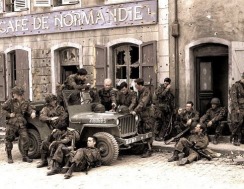
As the only road that tanks could use to get to and from the Omaha and Utah Beach areas ran through Carentan, it was imperative that this town be seized from the defending Germans and this was initially planned for June 7th. This was not to be and following stiffer than expected resistance the approaches to the town were not finally cleared through to St Come du Mont until June 10th. Carentan was easily defended by the Falschirmjager Paratroops of the 6th German Parachute Regiment owing to the low lying flooded areas surrounding the town.
Sights/Sites to see
As you will be shown with the strong German defense of such a crucial town the American forces used the whole Divison of the 101st Airborne Paratroopers to capture Carentan. From the north, the US forces had no choice but to assault down the main raised and exposed road that ran into the town south from Ste Mere Eglise. Aware of this, General Maxwell Taylor, commander of the 101st Airborne Division, planned to use almost his whole Division to encircle the town to squeeze it from all sides; the 327th Glider Infantry Regiment from the north and east, the 501st and 506th Parachute Infantry Regiments from the south west and the 502nd Parachute Infantry Regiment from the
north west. The attack by the 502nd Parachute Regiment on July 11th only succeeded in securing the exposed roadway before it was halted on the south bank of the flooded area just north of Carentan itself, but opened the way for further US units to move into the area. The following day the 506th Regiment was sent across the causeway to circle around to the southwest to help to secure the town, while the 501st Regiment circled around from the north following the 327th Regiment through the marshes. You will be shown the house used by the Germans as their main defense position during the attack by the 502nd Regiment on the 11th of June which was also the starting position for the 506th Parachute Infantry Regiment the following day. The US command knew the Germans would not give up the town without a fight as the German defenders had had 6 days to strengthen their defenses. You will see how each of the Parachute Regiments played their part in securing this town for the US forces landed into France during the summer of 1944.
Sights/Sites to see
As you will be shown with the strong German defense of such a crucial town the American forces used the whole Divison of the 101st Airborne Paratroopers to capture Carentan. From the north, the US forces had no choice but to assault down the main raised and exposed road that ran into the town south from Ste Mere Eglise. Aware of this, General Maxwell Taylor, commander of the 101st Airborne Division, planned to use almost his whole Division to encircle the town to squeeze it from all sides; the 327th Glider Infantry Regiment from the north and east, the 501st and 506th Parachute Infantry Regiments from the south west and the 502nd Parachute Infantry Regiment from the
north west. The attack by the 502nd Parachute Regiment on July 11th only succeeded in securing the exposed roadway before it was halted on the south bank of the flooded area just north of Carentan itself, but opened the way for further US units to move into the area. The following day the 506th Regiment was sent across the causeway to circle around to the southwest to help to secure the town, while the 501st Regiment circled around from the north following the 327th Regiment through the marshes. You will be shown the house used by the Germans as their main defense position during the attack by the 502nd Regiment on the 11th of June which was also the starting position for the 506th Parachute Infantry Regiment the following day. The US command knew the Germans would not give up the town without a fight as the German defenders had had 6 days to strengthen their defenses. You will see how each of the Parachute Regiments played their part in securing this town for the US forces landed into France during the summer of 1944.
